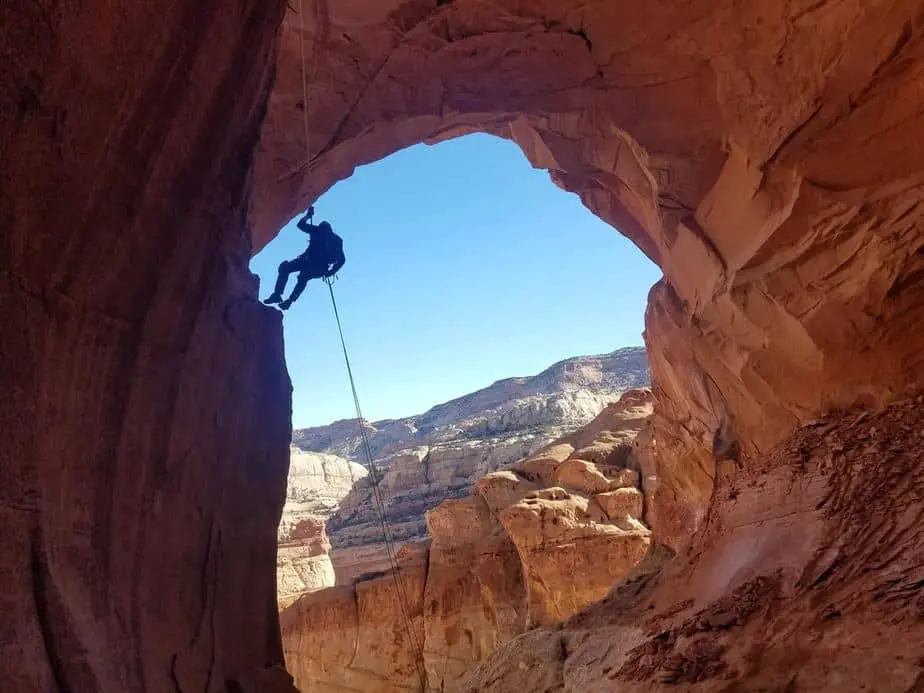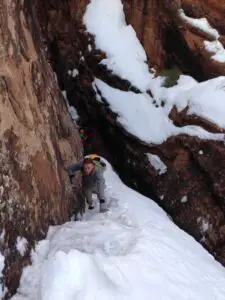One of the best parts about canyoneering is coming up on a rappel or turning a corner and having absolutely no idea what lies ahead. Is there an anchor? Is there water? Snow? How deep is it? You can’t bring an enormous backpack with everything you want in it- it may not fit through the slots, and will probably drown you if you try to swim with it.
What gear do I need for canyoneering?
- Helmet
- Sturdy Shoes
- Water/Food/Emergency Kit
- Harness/Rope/Hardware
- Webbing/Anchor Building Material
The amount of gear required to successfully descend a canyon depends on the canyon’s rating, the weather, and the technicality; however, some gear is essential for all canyons (for example, drinking water!). We will look into technical gear, clothing and footwear, and emergency gear.
Technical Gear for Canyoneering
Map/GPS:
Study up on the intended route prior to embarking on the adventure. Bring a topographical map with the route clearly marked, and identify landmarks and waypoints prior to dropping into the canyon, as well as while going through. A GPS works well too, but they don’t always get a good signal from the bottom of a canyon and batteries always seem to die (especially in the cold).
Many dangerous situations happen when canyoneers miss the exits at the bottom of the canyon, attempt to exit early, or rappel into the wrong offshoot. I usually bring 2 printed maps (one always ends up wet in my pocket) and take a picture of the route on my cell phone as a backup. Route finding can be one of the most difficult, and most dangerous aspects of canyoneering.

Helmet:
Keep your head safe. Rocks fall, people fall, bags fall, and somehow everything falls onto your head. The absolute last thing you want to happen in a canyon is a head injury. Swallow your pride and wear a helmet the whole time. Climbing helmets come with safety certifications from the UIAA (International Federation for Climbing and Mountaineering), and are specifically designed for the challenges inherent to climbing, rappelling, and canyoneering. If you’re going for the first time and aren’t sure you want to invest in an expensive helmet, just wear a bike helmet- but take it off for pictures!
Check out our recommended helmets in this article –
–
Harness:
Any climbing harness will do. That being said, canyoneering causes a lot more wear and tear on your harness than climbing does. Add that in with the stagnant pools of water in many canyons, and know that some harnesses are better for canyoneering than others. Look for a harness that won’t absorb a lot of water, that is simple to put on and take off, and doesn’t have a million gear loops and other straps hanging down.
You’ll primarily be rappelling in canyons, and simpler is better. A cushy climbing harness with ten gear loops will catch on rocks and branches, and will wear out more quickly when ground into sandstone (especially when wet!). If you have $150 burning a hole in your pocket, Petzl makes a bomb canyoneering harness .
.
Which harness is the best? Check out our recommended gear page –
–

Hardware:
The main gear required for canyoneering is a locking carabiner and a belay device . Personally, I like using a figure eight because I can control the speed based on the complexity of the rappel, but pretty much anything works. Bring a couple of extra locking carabiners too, just in case. If you drop your belay device off a cliff or into a keeper hole, you can make do with just a carabiner
. Personally, I like using a figure eight because I can control the speed based on the complexity of the rappel, but pretty much anything works. Bring a couple of extra locking carabiners too, just in case. If you drop your belay device off a cliff or into a keeper hole, you can make do with just a carabiner .
.
You should also bring a tether or personal anchor system so you can tie into the anchor point while setting up the rappels. If going to a new, unfamiliar canyon, bring ascenders in case you need to bail for any reason.
Should you use an ATC  or an 8 ring
or an 8 ring or something else? Read here for a deeper discussion of which belay device is best for canyoneering
or something else? Read here for a deeper discussion of which belay device is best for canyoneering –
–
Anchors:
The other hardware required for canyoneering is used for setting up anchors. Most well-travelled canyons have permanent, or semi-permanent anchors already. They usually either include climbing bolts and chains, or webbing with a quicklink or rap ring . When I started canyoneering, I never brought anchor equipment. We ended up getting stranded at the top of a 45 foot rappel because the webbing that had always been there in the past was gone. We were forced to do a very sketchy PG13 downclimb that I vowed never to repeat!
. When I started canyoneering, I never brought anchor equipment. We ended up getting stranded at the top of a 45 foot rappel because the webbing that had always been there in the past was gone. We were forced to do a very sketchy PG13 downclimb that I vowed never to repeat!
Always bring enough webbing (tubular webbing for climbing ) and quicklinks to be able to replace all of the anchors in a canyon. There’s no telling the state of the anchors after a season of flash floods, so it’s best to be prepared!
) and quicklinks to be able to replace all of the anchors in a canyon. There’s no telling the state of the anchors after a season of flash floods, so it’s best to be prepared!
Ropes:
Most people have a few different canyoneering ropes, but essentially you are looking for a long enough rope that is static- meaning that it won’t stretch. It’s useful to carry a 100 (30m) rope for short rappels and a 60 or 70m rope for long rappels. Check the guidebook to know what you need to bring beforehand. 9mm thick is usually good for canyoneering, as it saves on weight. I usually prefer brightly colored ropes because they look the best in pictures! You can check out our article on ropes for more information.
for more information.
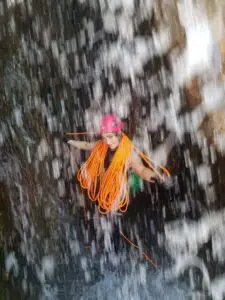
Aside from your regular rope, bring a handline (thin rope about 30ft long) and webbing (see the anchor section above). A great way to stretch the longest rappels is to rig a retrievable anchor with a thin diameter pull cord.
Our gear page shows the ropes we use and recommend –
–
Backpacks:
The number and size of the backpacks you need depends on the size of your group and the length of the canyon. With around 5 people, everyone can carry a small backpack, just big enough to hold gear and water. Everyone can divide out the gear belonging to the person carrying the rope bag (the rope bag needs to drain, and needs to be strong enough to be tossed without splitting).
For canyons that require wetsuits, more food and water, or even overnight gear, you will need much bigger backpacks. Make sure you bring a backpack that is abrasion resistant, as it will inevitably be ground into a canyon sidewall at some point. Get a bag with drains in it (grommets in the bottom of each of the pockets).
There’s nothing worse than trying to hike and swim with 40 pounds of water on your back! It’s helpful to have a carabiner on your bag so you can slide it down a makeshift ‘zipline’ rather than needing to rappel with it every time.
Canyoneering backpacks have special requirements. You can check out the packs we use and recommend at this link –
–
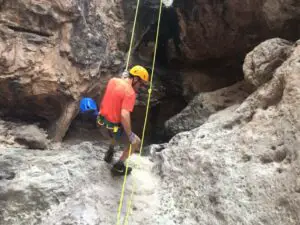
Dry Bag: (wet canyons)
You never know when you are going to encounter water in a canyon. If you drop your keys or phone or belay device in a keeper hole, you will never see it again! You can buy a really nice backpack/dry bag combination, but the easiest option is to buy a few different 5L and 10L bags you can store inside your regular backpack.
A 5L bag is perfect for a phone, keys, and a wallet, while a 10L bag will fit everyone’s phones, keys, and wallets, with room to spare (why are you bringing your wallet into the canyon?). Test it out in the bathtub before bringing it out into the wild, and make sure you understand how it seals. One of the best parts of having a dry bag inside your backpack is that it will usually make your backpack float, making swimming sections much easier. Some people bring a small pool floatie for this purpose.
Our recommended gear page shows the dry bags we use-
shows the dry bags we use-
Gloves: (optional, but recommended)
Don’t forget gloves for rappelling! Lots of companies sell gloves specifically designed for rappelling, but plain leather work gloves from a hardware store work just fine. You can also use a set of rubber-palmed gloves to help with downclimbing.
We wrote more about gloves, including recommendations at this link-
Clothing for Canyoneering
Shirts & Pants:
Clothing depends on the climate and size of your dry bag. A t-shirt and shorts work in most cases, but you may need extra layers for different situations. Avoid cotton because it dries really slowly and traps cold water close to the body. I usually wear a t-shirt with a wind shirt, a button up moisture-wicking, quick-drying long sleeved shirt, over the top. During wet sections I put the wind shirt in my dry bag and save it in case I get cold or need sun protection. On cooler days, or in longer canyons I bring a fleece jacket. I wear swimsuit shorts with lots of pockets that dry quickly.
Read more about what to wear in the Ultimate Guide to Canyoneering Clothing
Footwear:
Canyoneering involves a lot of very delicate moves that are often right on the edge of cliffs. Complicate it by adding water, which makes even the roughest of rocks smooth, and it ends up being a lot like walking on ice in some places. Regular tennis shoes and hiking boots work pretty well, but test them out first. Some tennis shoes turn into ice skates when they get wet, and some hiking boots feel like cement blocks when they’re wet.
Five Ten makes a shoe specifically designed for canyoneering, but they’re pretty pricey for an activity you can’t really do very often. Avoid waterproof shoes because they will make swimming more difficult and won’t drain while you hike. Check out our comprehensive guide to Canyoneering Footwear
specifically designed for canyoneering, but they’re pretty pricey for an activity you can’t really do very often. Avoid waterproof shoes because they will make swimming more difficult and won’t drain while you hike. Check out our comprehensive guide to Canyoneering Footwear .
.
The best pair of shoes I’ve used is a pair of Nike Hiking boots (my Nike Hike’s), surprisingly enough. Somehow they grip the rock like climbing shoes, and drain really well after water sections. In canyons that follow a permanent stream or river, I wear hiking sandals that cover my toes and heels, but still drain out. You don’t want to stub your toes on rocks below the surface of a muddy stream. Neoprene socks will help your feet stay a little bit warmer in cold water as well.
Wetsuit: (wet canyons)
Again, depending on the season and the amount of water involved, a wetsuit can really save the day. Hike in your regular clothes, and then throw your wetsuit on right at the top of the canyon. It is always colder in the bottom of a canyon. I’ve been the only canyoneer without a wetsuit a few times, and it makes a huge difference! I usually go for a 3mm shortie just to keep my core warm, but a full length wetsuit is better for colder climates and seasons. If you plan on going in the winter, you may consider investing in a dry suit. Wear a pair of shorts and a t-shirt over the top of your wetsuit to protect it against abrasion.
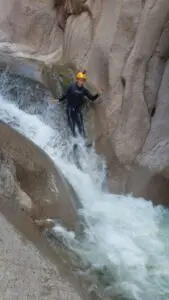
More details on wetsuits at this link –
–
Emergency Gear for Canyoneering
Canyoneering is inherently dangerous, and a lot can go wrong. Longer canyons sometime leave people stranded overnight, and a beautiful day can turn in an instant. Some injuries are inevitable- skinned knees and scraped hands. If everything does go wrong, it is crucial to be prepared for the worst. One of the best ways to plan for an emergency is by following the ‘Rules of 3’ idea that helps direct your efforts to the most immediate needs.
Within 3:
- Minutes: Make sure the victim can breathe. 3 minutes without oxygen can cause permanent damage
- Hours: Find or create shelter. If the sun goes down, it will get cold. If you are wet, this can be a serious problem
- Days: You will need a source of water. Yes, the human body can go 3 days without water, but certain functions will start shutting down
- Weeks: Humans can survive a long time without food, so it should not be the first priority
WIth that in mind, some emergency gear needs to stay in your backpack for every canyoneering trip:
needs to stay in your backpack for every canyoneering trip:
First Aid Kit-
Most injuries will be small cuts and scrapes, so triple antibiotic ointment (neosporin) and gauze are essential
Emergency Blanket (or bivy sack)-
These are literal life-savers in situations where you may end up spending the night. Additionally, they work very well to warm up a freezing canyoneer after an icy waterfall rappel or chilly swim. They pack up smaller than most jackets as well, so they fit nicely right in the bottom of your bag. It’s also nice to have a jacket (fleece).
Pocketknife-
There’s a reason ‘Swiss Army Knife’ has the connotation that it does
Lighter-
In case you need to start a fire to warm up
Water-
Bring plenty of water- water bladders work the best because they collapse as the day goes on, but water bottles work just fine too. Most canyons have a water source that you really, really shouldn’t drink without filtering. I use the Sawyer Squeeze as a filter, and it works very well. This year I got a LifeStraw
as a filter, and it works very well. This year I got a LifeStraw , and it is even more convenient!
, and it is even more convenient!
Headlamp-
Should you find a cave to explore or find the need to spend a night in the canyon, you will need a headlamp or a flashlight. The moon doesn’t shine very bright in the bottom of a canyon
Protein Bars-
While not completely essential for survival, a little bit of extra energy after a really long day will go a long way
Satellite Communicator-
Canyons don’t have cell phone service, and oftentimes even the trailhead and parking lot are a long ways from cell service. Hopefully it never pays for itself, but a satellite communicator can call in the cavalry if disaster strikes. My family uses a Spot Messenger , but we’ve never had to activate it (so far!) Some newer versions from Garmin and Bivvy allow you to actually type out messages.
, but we’ve never had to activate it (so far!) Some newer versions from Garmin and Bivvy allow you to actually type out messages.

